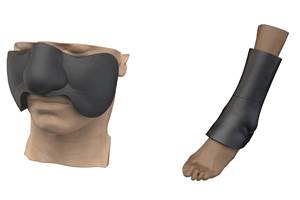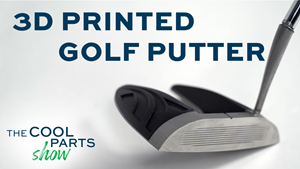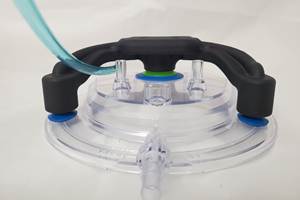Freeformer Enables Tailored Pharmaceutical Production
A 3D printer for polymer part production has enabled researchers from the University of East Anglia to develop individually tailored pharmaceuticals that better support patient needs and outcomes.
Share
Read Next
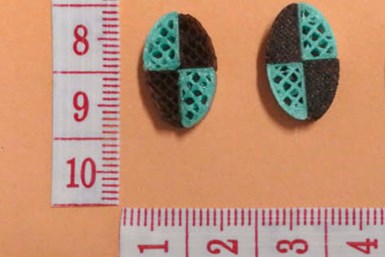
A research group at the University of East Anglia developed 3D-printed tablets that incorporate multiple active ingredients. The release rate increases as the filling level decreases, resulting in personalized dosages.
Photo Credit: Arburg
While medical devices, implants and custom-made prostheses have already given additive manufacturing a vital place in healthcare manufacturing, pharmaceuticals have historically lagged behind. Sheng Qi, a pharmaceutical engineer at the School of Pharmacy at the University of East Anglia (UEA), has recently made breakthroughs to change this, opening new possibilities in the delivery of patient-specific therapeutic and drug delivery.
With a 2019 report discovering that 44% of men and 57% of women over 65 take five or more drugs every week — with 12% of respondents in the group taking at least ten — proper delivery of pharmaceuticals is more important than ever. As most pharmaceuticals are composed of generic dosages of active ingredients, with generalized release patterns that may or may not meet a patient’s needs, overmedication and unwanted side effects are a recurring problem.
Qi’s research group means to eliminate this problem with personalized medicine. “By working alongside colleagues in hospitals and pharmacies, I have seen first-hand that customized tablets could be a solution for pediatric and geriatric patients, as well as those with complex chronic conditions,” she says.

Dr. Sheng Qi, pharmaceutical engineer and scientist at UEA’s School of Pharmacy, headed the research project into 3D-printed pharmaceuticals.
Photo Credit: University of East Anglia
Solving Material Issues
In 2015, Qi’s research group began investigating 3D printing pharmaceuticals through fused deposition modeling (FDM). She quickly discovered that this printing method would prove unsuited to her goals — many manufacturers only supply their own consumables, and the remaining platforms did not offer the medical-grade reproducibility she required.
FDM also proved a poor fit for the low thermal stability of pharmaceuticals, as the materials required thermal loading during both their extrusion into filaments and their discharge through a hot nozzle during the additive manufacturing process.
In 2019, Qi conducted trials with Arburg’s Freeformer printer, which uses the company’s proprietary Arburg plastic freeforming (APF) method and prints with granules rather than filaments. This industrial 3D system offers a higher level of material freedom, and especially suits pharmaceuticals, as the system is compatible with granules produced through traditional pharmaceutical granulation processes. The increased precision, flexibility and process stability of APF convinced Qi to focus her research group’s efforts on production with the Freeformer.
Freedom to Experiment
APF technology and the Freeformer are open systems that Arburg says are flexible to adaptation, including to the specialized requirements of this use case. Compatibility with standard granulates from common pharmaceutical polymers and active ingredients enabled Qi’s research group to proceed without additional plasticizers, instead discharging plastic melt as tiny droplets to additively manufacture individually tailored drugs. The group was also able to create and test a wide range of filling-level variants and experiment with the porosity of the tablet to regulate the active ingredient’s release rate. “The Freeformer offered our team the flexibility to optimize various densities and adjust them precisely,” Qi says. “The reproducibility of results was steady and robust.”
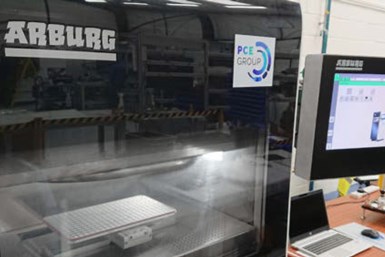
Arburg’s Freeformer works precisely with granule material, offering repeatability that made it suitable for AM pharmaceutical production.
Photo Credit: Arburg
Slicing software and material discharge as droplets support the deposition of fixed volumes. “This high level of precision is hugely important as it enables us to obtain uniform results,” Qi emphasizes. “With other technologies, we struggled to achieve consistent print results, and these are a prerequisite for targeted active ingredient release.” The APF process, by contrast, facilitated testing and evaluating various active ingredient combinations and their release rates. Qi’s research group could even explore the possibility of blending several drugs with specific dosages and packaging them in a 3D-printed tablet with sophisticated functional micro-structures designed to speed up patient recovery.
Personalized Results
To date, personalized pharmaceuticals have only been available to patients undergoing cancer treatment. Yet Qi believes personalized medicine for other diseases could improve therapeutic outcomes and enhance the patient experience. Faster patient recovery from individualized pharmaceuticals could also shorten stays in hospitals, saving money for both the healthcare facility and the patient.
An AM approach to pharmaceuticals also supports flexibility in treatment — other industries have seen lead times decrease from weeks to days with the transition to AM, and healthcare providers and pharmaceutical manufacturers could see this benefit as well.
Related Content
3D Systems, Klarity Partner to Expand Access to Patient-Matched Radiotherapy Innovations
Klarity has added 3D Systems’ VSP Bolus to its radiotherapy solutions, enabling radiotherapy clinics in the U.S. and Canada to embrace 3D printing technology without investing in costly, time-consuming software.
Read MoreResearchers Develop Method for Creating Customized 3D Printed Metals With Contrasting Properties
Researchers were able to use 3D printing techniques and tweak printing parameters to produce a 3D printed metal with different microstructures that create stronger and weaker regions in the exact locations in the metal that they wanted.
Read More3D Printed Putter Tailored to the Golfer: The Cool Parts Show #49
An engineering student in South Africa used metal and polymer 3D printing in tandem to create a putter customized to the individual golfer’s swing.
Read More8 Ways the Plastics Industry Is Using 3D Printing
Plastics processors are finding applications for 3D printing around the plant and across the supply chain. Here are 8 examples.
Read MoreRead Next
At General Atomics, Do Unmanned Aerial Systems Reveal the Future of Aircraft Manufacturing?
The maker of the Predator and SkyGuardian remote aircraft can implement additive manufacturing more rapidly and widely than the makers of other types of planes. The role of 3D printing in current and future UAS components hints at how far AM can go to save cost and time in aircraft production and design.
Read More4 Ways the Education and Training Challenge Is Different for Additive Manufacturing
The advance of additive manufacturing means we need more professionals educated in AM technology.
Read MoreHybrid Additive Manufacturing Machine Tools Continue to Make Gains (Includes Video)
The hybrid machine tool is an idea that continues to advance. Two important developments of recent years expand the possibilities for this platform.
Read More












.png;maxWidth=300;quality=90)



